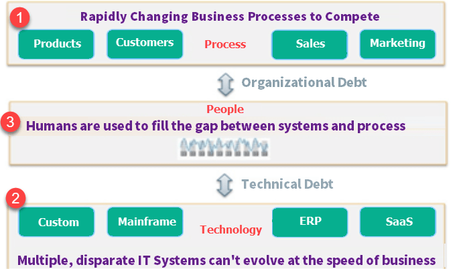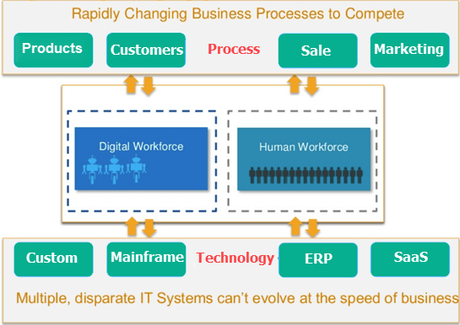A critical milestone in mankind’s progress was marked when a robot was awarded the citizenship of a country. Robots and automation have broken the shackles of our imagination and have become a part of our reality.
We have built machines to act and work like humans. Inching closer, we are giving robots the ability to think for themselves- just as we do, learn from their surroundings, and act on the basis of experience.
It is thus getting hard to discriminate between a human and an intelligent bot already.
Robotic Process Automation is one of the most exciting developments in Business Process Management in recent history. Some industry experts believe it may be even more transformational than cloud computing.
What is it?
RPA allows organizations to automate task just like a human being does it. Robotic automation interacts with the existing IT architecture with no complex system integration required.
RPA is a software program which runs on a user’s pc, laptop or mobile device. It’s a sequence of commands which are executed by bots under some defined set of business rules.
It can be used to automate workflow, infrastructure, back office process which are labor intensive. Software bots can interact with an in-house application, website, user portal, etc.
How does it work?
RPA robots are capable of mimicking most of the human actions. They log into applications, move files and folders, copy and paste data, fill in forms, extract structured and semi-structured data from documents, scrape browsers, and more.
Watch: RPA in motion
Consider the following scenario.
A typical enterprise uses multiple and disconnected IT systems to run its operations. With any change in the business process, a company would need to hire or train employees to map IT system and business process. Both solutions are time and money consuming.

Credit :Guru99.com
That’s where RPA comes in. With Robotic automation, the company can deploy virtual workers who mimic human workers.
In case of a change in process, a change in few lines of software code is always faster and cheaper than retraining hundreds of employees.
Reasons why Robotics Process Automation is advantageous
- A human can work average 8 hours a day whereas robots can work 24 hours without any tiredness.
- Average human productivity is 60% with few errors and a Robot’s productivity is 100% without any errors.
- Robots handle multiple tasks very well compared to a human being.

Credit :Guru99.com
Why every business needs RPA
Back-end routine tasks take up a lot of operational efficiency.
If these tasks are automated, the workforce can focus on the more essential ones, thus, skyrocketing the productivity of an organization.
Healthcare
- Patient registration
- Billing
HR
- New employee joining formalities
- Payroll process
- Hiring shortlisted candidates
Insurance
- Claims Processing & Clearance
- Premium Information
Manufacturing & Retail
- Bills of material
- Calculation of Sales
Telecom
- Service Order Management
- Quality Reporting
Travel & Logistic
- Ticket booking
- Passenger Details
- Accounting
Banking and Financial Services
- Cards activation
- Frauds claims
- Discovery
Government
- Change of Address
- License Renewal
Infrastructure
- Issues Processing
- Account setup and communication
Better accuracy
Software robots are programmed to follow rules. They never get tired or make mistakes. They are compliant and consistent.
Improved compliance
Once instructed, RPA robots execute reliably, reducing risk. Everything they do is monitored. Full control is maintained to operate in accordance with existing regulations and standards.
Fast cost savings
RPA can reduce processing costs by up to 80%. In less than 12 months, most enterprises already have a positive return on investment, and potential further accumulative cost reductions can reach 20% in time.
Super scalable
Across business units and geographies, RPA performs a massive amount of operations in parallel, from desktop to cloud environments. Additional robots can be deployed quickly with minimal costs.
Increased speed and productivity
Employees would appreciate the benefits of RPA as it removes non-value-added activities and relieves them from the rising pressure of work.
According to a report by Forrester, the Enterprise Robotic Process Automation market is expected to reach over $2.9 billion by 2023, while Statista believes the industry will be worth $4.9 billion by just 2021.
Studies at Hadoop estimates the potential savings for companies that deploy RPA stand between $5 trillion to $7 trillion, by 2025. By 2025, RPA softwares will be performing tasks with an output level that will be equivalent to 140 mn full time employees.
Also Read | 8 businesses that can thrive by integrating machine learning in 2019
RPA adoption will be universal in no time. If you happen to be an enterprise looking to streamline and automate processes, the time to act is now.





